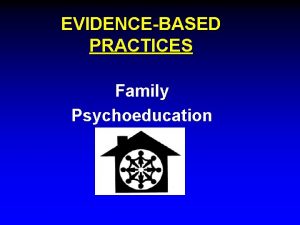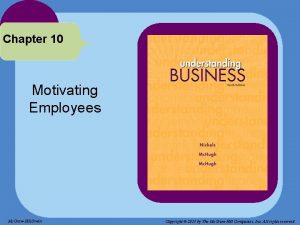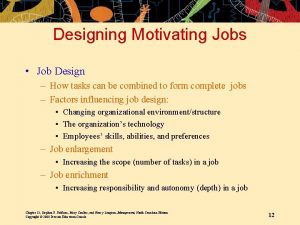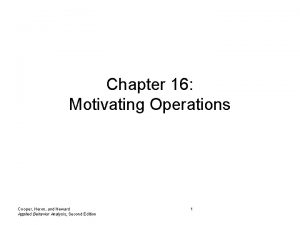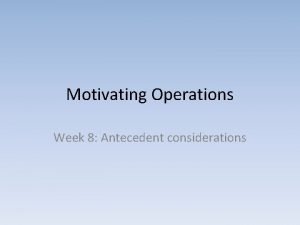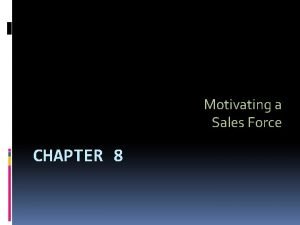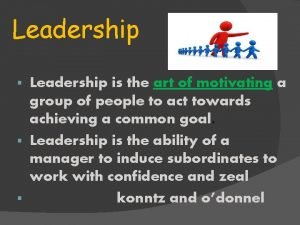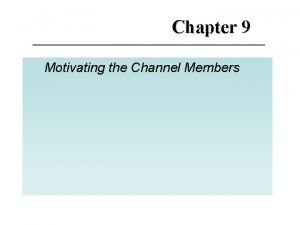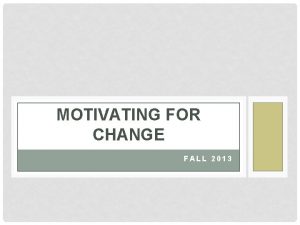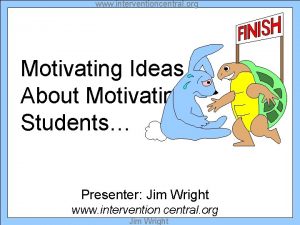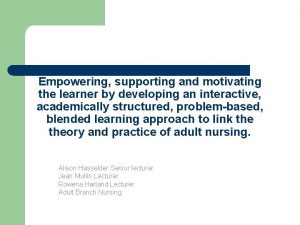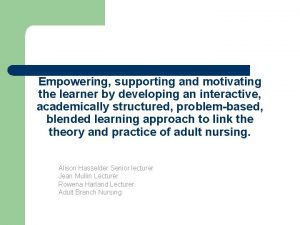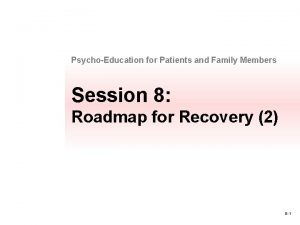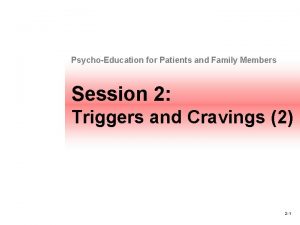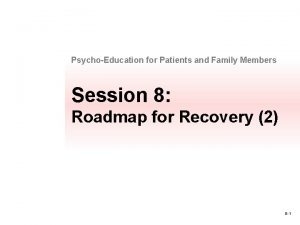Chapter 5 Psychoeducation Teaching Supporting and Motivating Psychoeducation


























- Slides: 26

+ Chapter 5 Psychoeducation: Teaching, Supporting, and Motivating

+ Psychoeducation

+ Psychoeducation n. A major tenet of CBT is that clients will need to learn new skills as they collaboratively participate in their own therapy n Another major tenet of CBT is to provide clients with the knowledge and ability to effectively apply cognitivebehavioral skills autonomously n Goal is to have clients be their own CBT therapists where they can independently solve their life problems long after therapy is over

+ Psychoeducation n Some therapists, especially those early in their career, view psychoeducation with disdain as something that is not worth the time with little value May be due to feeling vulnerable to be in the expert role (e. g. , must know the CBT model really well) n May be due to a strong desire to immediately begin specific steps to reduce client distress (i. e. , focused more on the outcome than the process) n n Psychoeducation n helps establish therapeutic rapport Not lecturing – modeling for clients the collaborative role in their own treatment

+ Psychoeducation n Psychoeducation has a continuous role through all phases of therapy n Two main parts: Early phase CBT psychoeducation – a formal process where general expectations for therapy and information related to your clients’ diagnosis and problems n CBT skill psychoeducation – As therapy progresses, there will be multiple opportunities for psychoeducation where a new skills needs to be taught and practiced n

+ Early Phase Psychoeducation

+ Early Phase Psychoeducation n Most of the initial psychoeducation content is relatively nonthreatening (e. g. , therapy expectations, cognitive model) n This process allows the client to naturally acclimate to therapeutic experience instead of being put immediately on the spot by being asked a deeply personal question or expected to engage in a new behavioral routine n Information motivation n can also be used to build optimism and Educating clients about their specific condition (i. e. , diagnosis) and how CBT has legitimate potential to reduce their distress and improve their quality of life can be just enough to consider remaining in therapy in order to “give it a chance”

+ Early Phase Psychoeducation n Prepare in advance before educating clients on specific topics n Knowledge is important, but it is also important to know how to communicate this information in a way that clients can both understand be engaged n *If you come off as unsure or unclear about these topics and/or have minimal client interactions due to being rigid or scripted, your therapeutic rapport could be damaged, or, worse, your client may terminate prematurely

+ Early Phase Psychoeducation n Table 5. 1 – Early Phase Psychoeducation Worksheet Can be helpful in providing a template to ensure that certain information is addressed with your clients soon after your intake n A brief description of relevant content is provided for each topic, and there is space available for your own clientspecific notes n


+ Therapy Expectations n Like setting a broad agenda for therapy as a whole rather than for just one session n Clients come to therapy with different expectations For those with no expectations, explaining CBT can provide some comfort by minimizing the mystery of therapy and setting structure n For others, their expectations and/or previous therapeutic experiences may not be similar to how CBT actually works n n Thus, you might be in the position to adjust their expectations or even “retrain” their role as a client, especially if they have received a form of non-directive therapy in the past

+ Therapy Expectations n At this point in therapy, it is generally best to be brief and simple in your explanation of therapy expectations n Spending too much time on this topic and/or using too much CBT jargon has the potential to intimidate and overwhelm clients n There will be many other opportunities to provide psychoeducation about specific topics and skills

+ Therapy Expectations n Information that should be addressed while discussing therapy expectations (See Table 5. 1): Collaboration n Session structure n Goal directed n Taking notes n Homework n Challenge ways of thinking and behaving n Moments of increased distress before reduced n Autonomy n

+ Cognitive Model n Must be reviewed early in therapy because it sets the foundation for how clients’ problems are conceptualized and treated n Relationship between triggering events, automatic thoughts (or images), emotional and physiological responses, behaviors, and associated outcomes n Visual models using a client specific example See Figure 1. 1 – Reciprocal Cognitive-Behavioral Model n Can also use handouts or whiteboard n

+ Early Phase Psychoeducation n Video n Vignette 5. 1 (p. 110) MDD-4: Psychoeducation – Therapy Expectations and the Cognitive Model n *Discussion questions and an activity will follow Video Vignette 5. 2 (psychoeducation of diagnosis)

+ Diagnosis, Case Formulation, and Treatment Plan n Psychoeducation of diagnoses and associated problems Most clients often feel at least some relief when informed of their diagnosis because it is a step closer to understanding their distress n Help normalize experience by discussing common symptoms, incidence/prevalence rates, and possible etiological factors n n While normalizing be cautious to not minimize their own unique experiences n Cannot promise to fully “cure” clients but can assure them that past clients with similar diagnoses and problems have been treated with positive outcomes

+ Diagnosis, Case Formulation, and Treatment Plan n Initial case formulation Can use your CBT model of psychoeducation of diagnoses and problems as a backdrop to explain your conceptualization of your clients’ distress n Be open to client feedback and do not present your case formulation as infallible; it will evolve over time n n Treatment n plan – goals and interventions Better treatment compliance when there is a collaborative understanding and mutual agreement of the precipitating and maintaining factors for client distress and an understanding why specific interventions will be used

+ Early Phase Psychoeducation n Video n Vignette 5. 2 (p. 114) PDA-4: Psychoeducation – Diagnosis n Discussion n Activity Questions 5. 1 (p. 116) 5. 1: Psychoeducation (p. 116)

+ CBT Skill Psychoeducation

+ CBT Skill Psychoeducation n Beyond early phase psychoeducation, there will be many moments of psychoeducation during essentially every session n There is significant variation of psychoeducation content during the middle and late phases of therapy n Depends on clients’ type of distress and severity n Two components that receive focus here include: Teaching new skills n Bibliotherapy and technology n

+ Teaching New Skills: In-Session Practice to Between Session Application n Provide many “mini-lessons” for new skills – accumulate into “big” cognitive-behavioral skills n Use examples specific to your clients’ presenting problems Scaffold your clients through each step of the exercise n A copy of the completed exercise or a photo of the whiteboard can be used as a template for clients to study and use outside of session n A therapy notebook can be used to organize completed exercises n Homework assignments, handouts, client therapy notes worksheets, and self-report measures n

+ Teaching New Skills: In-Session Practice to Between Session Application n There will also be opportunities where it is most appropriate for clients to practice and apply their new skills beyond written exercises n First practice these new skills in session because they can sometimes be distress provoking for some clients n Also allows for you to provide direct feedback to ensure that the skills are being applied appropriately

+ Bibliotherapy and Technology n There are many self-help books and related materials available through multiple avenues of technology (e. g. , professional mental health websites, computer programs/games, smartphone applications) However, without appropriate professional assistance, many of these resources do not provide long-term effective change; and in some cases can cause more harm n Your role as a therapist is to be judicious in what CBT materials are assigned to your clients and continuously monitor its impact on therapy n

+ Bibliotherapy and Technology n Consider the phase of therapy and your clients’ level of intelligence, cognitive and emotional sophistication, and psychological self-awareness n You should read and review any resources you assign to your clients in advance n You must understand the content in order to determine appropriateness and monitor clients’ use n Your assigned resources will be most effective if they are purposefully integrated into your treatment plan n What clients are reading and using outside of session should match what is being covered in session

+ Common Challenges for CBT Psychoeducation

 Motivating and satisfying employees and teams
Motivating and satisfying employees and teams Is the individual internal process that energizes directs
Is the individual internal process that energizes directs Psychoeducation
Psychoeducation Psychoeducation
Psychoeducation Psychoeducational model
Psychoeducational model Ddddmm
Ddddmm Psychoeducation
Psychoeducation Chapter 10 motivating employees
Chapter 10 motivating employees Chapter 10 motivating employees
Chapter 10 motivating employees Chapter 10 motivating employees
Chapter 10 motivating employees Motivating and satisfying employees and teams
Motivating and satisfying employees and teams Motivating and satisfying employees and teams
Motivating and satisfying employees and teams Motivating and satisfying employees and teams
Motivating and satisfying employees and teams Motivating yourself and others
Motivating yourself and others Palatable
Palatable Phases in micro teaching
Phases in micro teaching Motivating parallelism
Motivating parallelism How to motivate esl students
How to motivate esl students Herzberg’s two-factor theory
Herzberg’s two-factor theory Designing motivating jobs
Designing motivating jobs Dimensions of behavior altering effects are:
Dimensions of behavior altering effects are: Automatic reinforcement aba example
Automatic reinforcement aba example Motivating operations definition
Motivating operations definition Motivating sales force
Motivating sales force Leadership is the art of motivating a group
Leadership is the art of motivating a group Motivating channel members
Motivating channel members Planning controlling organizing staffing and directing
Planning controlling organizing staffing and directing




